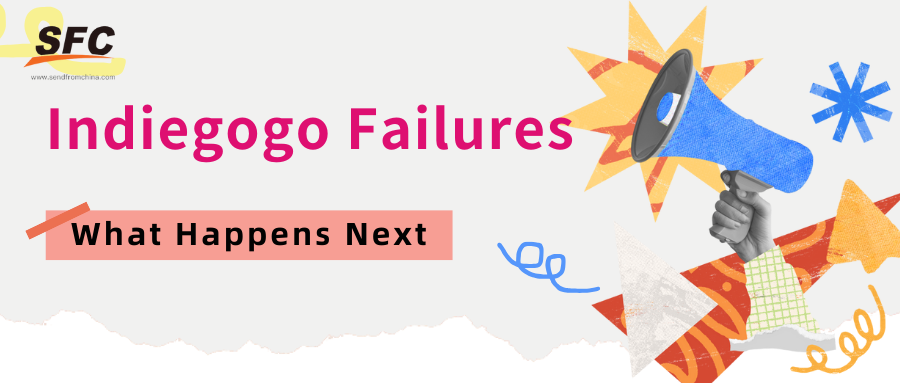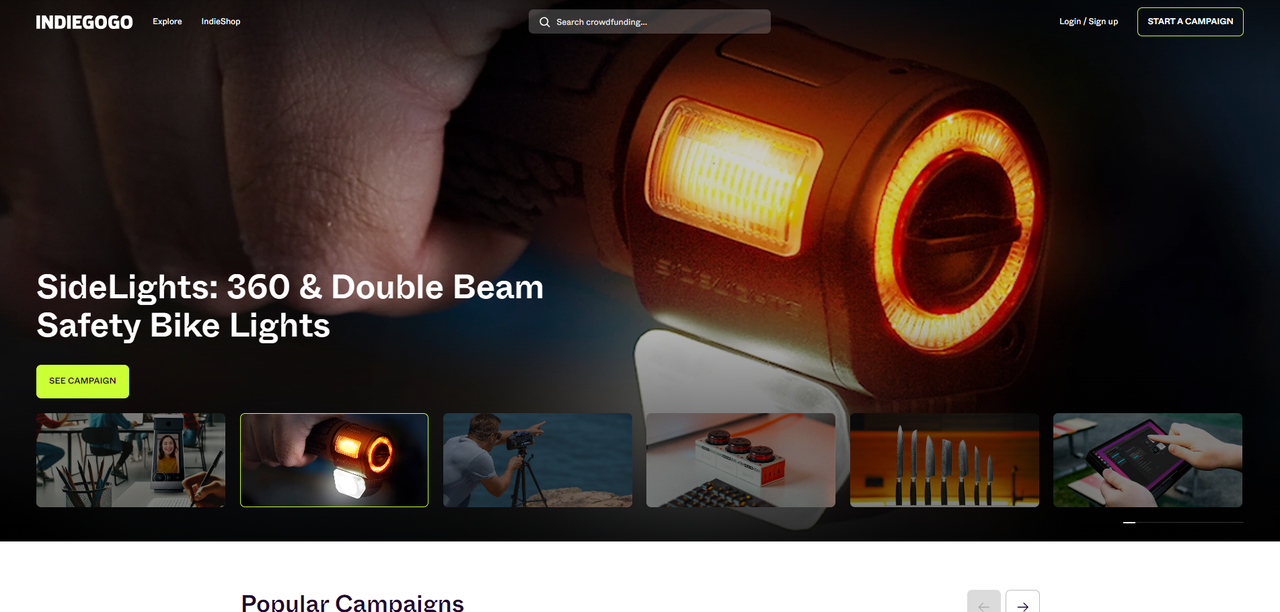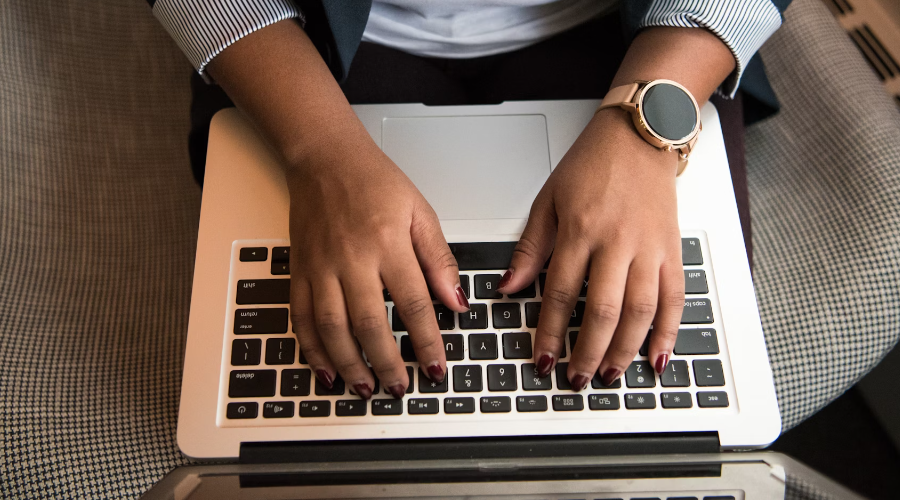Table of Contents
Indiegogo Failures: What Happens Next and How to Bounce Back Stronger
Time: Oct 14,2024 Author: SFC Source: www.sendfromchina.com
Launching a campaign on Indiegogo can be an exciting venture, offering creators the chance to bring their innovative ideas to life with the support of a global audience. However, not every campaign meets its funding goals or delivers as promised, leaving creators facing the tough reality of project failure. If your Indiegogo campaign didn’t succeed, you’re not alone—many entrepreneurs face similar setbacks. The good news is that failure doesn’t have to be the end of the road.In this guide, we’ll explore what happens after an Indiegogo project fails, common reasons campaigns fall short, and, most importantly, actionable steps to bounce back stronger, rebuild trust, and potentially relaunch your project for future success

1. Understanding the Journey Through Indiegogo
Indiegogo has revolutionized the way creators, entrepreneurs, and innovators bring their ideas to life. With an open platform designed to democratize access to funding, it allows anyone with a compelling idea to pitch to a global audience. From cutting-edge gadgets to socially impactful projects, Indiegogo has empowered creators to bypass traditional financing hurdles. However, not every campaign succeeds, and understanding the lifecycle of an Indiegogo project is critical to navigating both success and failure.The journey begins with a clear vision, but the reality of bringing that vision to fruition is more complex than many realize. Indiegogo projects require meticulous planning, consistent marketing efforts, and a clear understanding of what backers expect in return. Despite the best of intentions, many campaigns don't reach their funding goals or fail to deliver on promises. When failure occurs, the next steps are crucial to ensuring that the setback doesn’t mark the end of your entrepreneurial journey.
2. Indiegogo's Policy on Failed Projects

Indiegogo, as a platform, has a straightforward policy regarding failed projects. It’s important to note that Indiegogo operates under a “flexible funding” model, meaning that project creators may receive funds even if their campaign doesn't fully meet its financial goals. It can lead to complications when projects fail post-funding, particularly in the eyes of backers.
According to Indiegogo's terms, the responsibility for delivering on promises lies solely with the campaign creator. The platform does not guarantee that creators will fulfill their commitments. If a campaign fails, Indiegogo encourages creators to update backers on the situation and offer a resolution—be it refunds, partial deliveries, or an alternative plan. However, there is no enforceable obligation from Indiegogo's side to ensure backers get their money back if the project collapses.
This policy requires creators to manage relationships with backers and navigate the aftermath of failure with transparency and integrity. Proper communication during this period is key, as it can either mitigate backlash or escalate frustrations.
3. Common Reasons for Indiegogo Project Failure
While each campaign is unique, there are recurring themes in why projects fail on Indiegogo. Identifying these pitfalls can help future creators avoid making the same mistakes.Unrealistic Funding Goals
An unrealistic funding goal creates a barrier to gaining momentum and backer confidence. High goals can deter potential supporters who may feel their contributions won't have a significant impact, especially if the campaign is far from reaching its target. Crowdfunding campaigns often thrive on early excitement and perceived success; when backers see that a project is struggling to meet an ambitious goal, it can lead to a loss of enthusiasm and decreased visibility, as backers are less likely to share or promote campaigns that seem destined to fail.Lack of Planning and Research
Many campaigns fail due to inadequate preparation. Launching a crowdfunding campaign on Indiegogo is not as simple as posting a project page and waiting for funds to roll in. It requires extensive research into the target audience, competitor analysis, market demand, and even logistics. Skipping these steps can doom a project before it starts.Projects that lack a well-thought-out timeline, production plan, or distribution strategy are particularly susceptible to failure. Backers expect a clear roadmap of when they will receive their rewards, and any deviation from that without prior explanation often leads to distrust and disappointment.
Underestimating Costs and Budget Overruns
It’s easy to be optimistic when calculating a project's financial needs, but unforeseen expenses are a leading cause of failure. Many creators underestimate the actual costs of manufacturing, shipping, taxes, and even marketing. This results in budget shortfalls, making it impossible to deliver promised rewards to backers.Projects that over-promise and under-deliver are particularly prone to failure. Budget mismanagement leads to delays, compromises in product quality, or, in the worst cases, complete project abandonment.
Insufficient Marketing and Outreach
A great idea is not enough to guarantee success on Indiegogo. Many projects fail simply because they don’t reach enough potential backers. In today's saturated crowdfunding space, you need a strong marketing strategy to cut through the noise.Campaign creators who do not invest time and resources into building a pre-launch email list, generating social media buzz, or reaching out to influencers often struggle to meet their funding goals. A project’s success is largely dependent on how well its creators can market it to their target audience.
Unclear Value Proposition
Another common reason for failure is the inability to clearly communicate the value of the project. If backers don’t understand why your product or idea is valuable to them, they won’t contribute.Indiegogo campaigns must have a compelling story, addressing not only what the product is but why it matters. Projects that fail to differentiate themselves from competitors or do not clearly explain how they will benefit the user often struggle to gain traction.
4. What Happens Next and How to Bounce Back

Dealing with Backers Post-Failure
The first and most important step after a failed Indiegogo campaign is to address your backers. Open and transparent communication is crucial in maintaining trust, even if you cannot deliver on your initial promises. Many failed campaigns escalate into public relations nightmares due to poor handling of backer communication.Be honest about the challenges you faced, explain why the project failed, and offer potential resolutions. Whether it's offering partial refunds, additional perks in future campaigns, or an apology, your approach should be centered on maintaining integrity. Transparent communication can often salvage your reputation even in the face of failure.
Learning From Failure: Analysis and Reflection
The next step is to evaluate the reasons behind your failure. Take a step back to analyze what went wrong. Did you misjudge the market? Were your costs higher than expected? Was your marketing insufficient?By conducting a thorough post-mortem, you can learn valuable lessons that will improve your chances of success in future endeavors. Failure is a powerful teacher, and understanding its root causes is essential for growth.
Rebuilding Trust: Open Communication
Trust is everything when it comes to crowdfunding. Even if you failed to deliver on your initial project, staying engaged with your community of backers is critical. Offering updates, being available to answer questions, and addressing concerns proactively can help rebuild trust.If you plan to relaunch a project or start a new one, maintaining an open line of communication with your previous backers can make all the difference. Many creators who have failed in the past go on to launch successful projects by showing that they have learned from their mistakes and are committed to transparency.
Revisiting the Project or Moving On
Once you've dealt with the immediate aftermath, it's time to decide whether to continue with your project or move on to something new. If you still believe in the potential of your idea, you may want to consider revisiting it with the lessons you’ve learned from failure.This might mean reworking your budget, adjusting your marketing strategy, or partnering with someone who has expertise in areas where you struggled. Alternatively, if the project is no longer viable, don’t be afraid to pivot and focus on new opportunities. Sometimes, the best course of action is to let go and move on to a more promising venture.
Funding Alternatives After Indiegogo
Indiegogo isn't the only option for funding your project. If your campaign has failed, you may want to explore alternative funding sources. Consider looking into platforms like Kickstarter, GoFundMe, or equity crowdfunding sites. Additionally, traditional routes like seeking venture capital, applying for grants, or using personal savings are always options.The key is to use the lessons learned from your failed campaign to approach future funding opportunities with more preparation and a refined strategy.
5. FAQs
1. What happens if an Indiegogo project fails to deliver?
If a project fails to deliver, creators are encouraged to update backers and provide an explanation. However, Indiegogo does not enforce refunds or project completion. The responsibility lies with the creator.2. Can I get my money back if a project fails on Indiegogo?
Indiegogo’s flexible funding model means that creators may keep the money even if the project fails. While some creators may offer refunds, there is no guarantee that backers will receive their money back.3. How can I bounce back after a failed Indiegogo campaign?
Bouncing back involves analyzing the reasons for failure, communicating transparently with backers, and either revising the project for a relaunch or moving on to a new idea.4. What are the common reasons for Indiegogo campaign failures?
Common reasons include poor planning, underestimating costs, insufficient marketing, and a lack of a clear value proposition.5. Can I relaunch a failed Indiegogo project?
Yes, many creators have successfully relaunched failed projects by learning from their mistakes, improving their approach, and re-engaging their audience. Post Views:4293
Post Views:4293
Copyright statement: The copyright of this article belongs to the original author. Please indicate the source for reprinting.
Previous Post
What Is Zone Picking & How Does Zone Picking Work
Next Post
TAGS
Hot Research
Get a Custom China Fulfillment Solution with FREE Storage for 60 Days
 Want to know about our services, fees or receive a custom quote?
Want to know about our services, fees or receive a custom quote?
 Please fill out the form on the right and we will get back to you within a business day.
Please fill out the form on the right and we will get back to you within a business day.
 The more information you provide, the better our initial response
will be.
The more information you provide, the better our initial response
will be.





 TAGS:
TAGS: